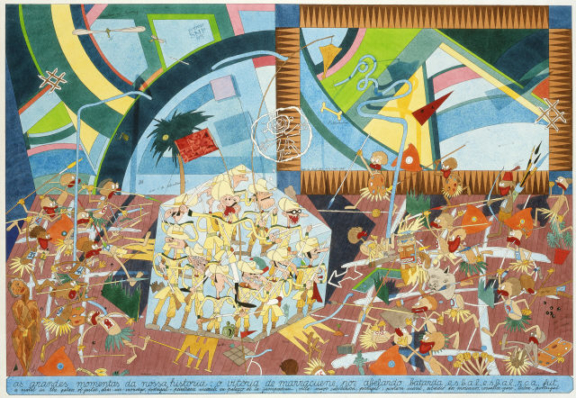
- 1973
- Paper
- Indian ink and Watercolour
- Inv. 98DP1726
Eduardo Batarda
O Vitória de Marracuene [The Victory of Marracuene]
This is one of the largest works that Eduardo Batarda painted in watercolour, a technique that he perfected during the time he was studying in London with a grant from the Calouste Gulbenkian Foundation (1971-1974). Batarda’s watercolours are painterly experiments, aiming to enable the coexistence of a high level of technical excellence (a competence adopted with a pinch of irony) with vernacular iconography and a series of critical and intellectually challenging commentaries on actuality and art. This insistence on the specificity of painting is emphasised by the scale of this work, inviting different readings, depending on the distance from which it is viewed. The painting solicits a dance of approach such as is performed by the informed observer of great works of art. The admiration and veneration implied in this cliché stand in stark contrast with the type of figuration that Batarda employs, soaking up the idioms of both classic and underground comic strips: cynical caricatures of (occasionally) corrosive humour and with instances of pornography.
The title refers to the battle that took place in 1895 in Marracuene, Mozambique, in which Portuguese soldiers lined up in square formation, which was however disrupted on a number of occasions by their opponents, who were armed with only lances. The combat took place in the context of a bloody dispute occasioned by a series of local revolts. Batarda is here playing on an obvious parallel with the Colonial War that was underway when he painted this work.
In 1977, while on exhibition in Bulgaria, the work was boycotted by African university students who thought it had racist connotations. The mistaken interpretation was based on the stereotyped representation of Africans, in particular in Batarda’s use of the image of picaninnies, a corrupt form of the Portuguese pequenino, meaning small or little one, designating first black children and later all representations of big-eyed, thick-lipped Africans, like those used in cartoons and advertisements. The artist’s aim, in using such motifs, was ironic: in fact both anti-racist and anti-colonial. These figures attack a transparent cube in the middle of the work, in which we see the white colonials, uncouth and no less stereotyped. This ‘square formation’ (leaning actually towards a triangle, with its religious connotations) could also be seen as a reactionary pictorial epithet. The action takes place on a stage whose backdrop consists of recognisably modernist abstract motifs whose decorative use is also a critical commentary. Closer observation reveals that instead of lances and arrows, the weapons of most of the natives are paintbrushes, while their shields are palettes. Together with other art-historical allusions, they invite us to read this combat through a new lens: as an attack launched by the neo-vanguards (dope-smoking, chaotic, pugnacious) against a fossilised modernism, academic and obsolete, but to which the vanguards are themselves indebted, for instance in the repetition of modernist primitivisms under the guise of ‘anthropological’ art.
On the bottom border of the painting a caption is written on a blue ground, reminiscent of those appended to old didactic engravings reproducing paintings and indicating the title of the work, the artist, the location, school and so forth.
MPS
May 2010
| Type | Value | Unit | Section |
| Width | 100 | cm | |
| Height | 69 | cm |
| Type | date |
| Text | 73/12 |
| Position | bottom left corner |
| Type | signature |
| Text | Batarda |
| Position | bottom left corner |
| Type | inscription |
| Text | «Functions of Painting», «Prémio SNI 1973», «l’illustration», «toile de fond par M.M. 1960-1968», «essa é de rebimbòm[…]o!», «beauté créole», «Silbes», «Tunes», «boa noite e lepra!», «ad reinhardt 63», «Batarda 73/12», «as grandes momentas da nossa história: o vitória de marracuene, por abelardo batarda, e.s.b.a.l., e.s.b.a.l., r.c.a., fut. a mural in the palace of justice, elvas-sur-mondego, portugal – peinture murale au palazzo de la jurisprudence, villa major carvalhosa, portugal; pintura mural, estádio dos moicanos, versailhes-gare, lisboa, portugal» |
| Type | Acquisition |
| Date | February 1998 |
| Linhas de Sombra / Shadow Lines |
| Lisbon, Fundação Calouste Gulbenkian e Centro de Arte Moderna, 1999 |
| ISBN:972-635-115-4 |
| Exhibition catalogue |
| Um Oceano Inteiro para Nadar |
| Lisbon, Culturgest, 2000 |
| Exhibition catalogue |
| Eduardo Batarda: Pinturas, 1965-1998 |
| Lisbon, Fundação Calouste Gulbenkian, Centro de Arte Moderna José Azeredo Perdigão, 1998 |
| Exhibition catalogue |
| Eduardo Batarda Fernandes |
| Lisbon, Fundação Calouste Gulbenkian, 1975 |
| Exhibition catalogue |
| Eduardo Batarda - Pinturas 1965-1998 |
| CAMJAP/FCG |
| Curator: Alexandre Melo |
| 3 March to 10 May 1998 CAM, Gallery 1 |
| Transfert - Obras do CAMJAP em Itinerância/ Itinerant CAMJAP works |
| Fundação Calouste Gulbenkian |
| Curator: Leonor Nazaré |
| 16 June to 8 Setptember 2007 Palácio da Galeria/ Museu Municipal de Tavira |
| Linhas de Sombra / Shadow Lines |
| Fundação Calouste Gulbenkian |
| Curator: João Miguel Fernandes and Maria Helena de Freitas |
| 29 January to 18 April 1999 Lisbon |
| Um Oceano Inteiro para Nadar |
| Culturgest |
| 2000 Culturgest, Lisbon |
| Eduardo Batarda Fernandes |
| Fundação Calouste Gulbenkian |
| Curator: Fundação Calouste Gulbenkian |
| 1975-08-01 to 1975-08-31 Temporary exhibition gallery - Calouste Gulbenkian Foundation, Lisbon |
| Portuguese Contemporary Art |
| Exhibition in Belgrad, Bucareste, Athens, Sofia, 1977. |
